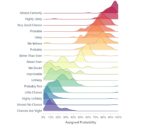
by tyler garrett | May 25, 2025 | Data Visual
In the realm of complex business decisions, clarity is power. Data visualizations serve as essential tools, turning complicated data streams into understandable information. Yet, without appropriate annotations and references, even the most visually compelling graphics risk falling short. Annotations and reference notes act like signposts, guiding decision-makers through visual data narratives to the critical insights they need. Understanding how to harness these tools effectively can bring substantial benefits: improved decision-making speed, enhanced interpretability, greater accuracy, and more impactful presentations. At our software consulting firm, we’ve guided organizations across many industries—from construction management companies leveraging our specialized Procore API consulting services, to healthcare facilities in Austin benefiting from advanced data analytics transformations. Today, let’s explore how annotations and references can elevate your explanatory visualizations.
Why Annotations are Crucial for Visual Impact
Annotations serve as explanatory footnotes within data visualizations. Whether it’s a time series plot, a heatmap, or a complex scatter plot, annotations help the audience zero in on vital information. Highlighting key metrics or pointing out anomalies allows viewers to quickly understand the critical elements of your data story. Too frequently, visualizations are presented barebones—assuming the data alone tells the story. However, decision-makers need context mapped directly onto visuals to quickly comprehend results and implications.
For instance, when documenting significant operational milestones in a time series, annotations can succinctly communicate specific organizational changes, market events, or even compliance regulations at particular periods. This targeted approach makes visualizations not merely informative but inherently persuasive and actionable. Moreover, smart annotations are indispensable for streamlining communications in reports and dashboards, ensuring audience understanding without overwhelming viewers with excessive detail.
Consider a recent implementation pattern from our experts in stream table join implementation patterns. By clearly annotating specific join points within visual data flows, stakeholders could quickly grasp the underlying logic and architecture of data streams, facilitating faster buy-in and improved technical clarity. Strategically blending annotations with visual content ensures precise communication of data-driven insights.
References: Establishing Credibility and Reliability
References build trust in your visualizations. When stakeholders make important strategic decisions based on data visualizations, they require assurance that the underlying data is valid, verifiable, and credible. Clearly identified references supply decision-makers with the confidence that visualizations derive from reputable and verifiable sources. Effective referencing contributes to transparency, accountability, and ultimately better decision-making.
A reference may point to external data sources, scientific journal articles, or industry reports. Additionally, visualizations referencing known standards, guidelines, or compliance regulations enhance trust and professional insight. For example, healthcare organizations rapidly adopting advanced analytics must explicitly reference credible sources, as detailed in our recent article on how data analytics is transforming the healthcare industry in Austin. Linking visual analytics directly to credible external sources reassures viewers that data is reliable and accurate.
Moreover, referencing internal business systems, such as Tableau visualizations within an enterprise, builds data literacy and ensures smoother decision-making workflows. Our guide on how to install Tableau desktop equips decision-makers with reliable resources for utilizing trusted visualization software. Thus, references reinforce visualizations by providing assurances of authoritative and objective data sources—critical for strategic interpretation and confident decision making.
Best Practices for Annotation and Reference Integration
Mastering annotations and references in your data visualization effort requires particular attention. Storytelling clarity is essential; optimal integration ensures your annotations or references do not obstruct or confuse the main message. The goal should always be to enhance meaning without overwhelming visual complexity. A strategic content hierarchy, combined with visual style consistency, is key—keeping text succinct and visually non-intrusive.
Strategically placed annotations help instill context without creating clutter. Contextual pop-ups, intuitive markers, and flexible interactive visualization frameworks enable exploration without visual overload. Similarly, references ideally should reside unobtrusively, yet be quickly accessible when credibility verification is essential. Techniques such as endnotes, clickable sources, or embedded hyperlinks keep visualization interfaces clean yet provide vital supporting evidence.
Our article detailing semantic layer optimization for multi-dimensional analysis demonstrates effective practice by clearly connecting visual outputs directly to the semantic layer itself. The referenced optimization details reinforce the credibility while annotations indicate potential performance impacts clearly. Adopting these practices ensures visualizations not only remain compelling and informative but maintain transparency within visualization-driven analytical workflows.
Interactive Annotations in Modern Data Visualization Tools
Modern visualization tools increasingly prioritize interactivity, and annotations are no exception. Allowing stakeholders to interactively engage with annotations provides deeper insights without visual clutter. Interactive annotations provide contextually relevant notes and highlights dynamically, delivering clarity and enhancing user empowerment. Decision-makers appreciate interactive annotations because they provide control, allowing stakeholders to reveal supplemental information as needed.
For instance, platforms like Tableau offer extensive interactive annotation features. Not only can users hover over data points for more context, but advanced embedding options—like those discussed in our article about configuring SAML forward proxy Tableau—enable secure, personalized views tailored to decision-makers’ roles. These interactive annotation systems optimize focus and prevent information overload.
Interactive annotations also empower technical teams—offering efficient management processes. As outlined in our recent explanation of Canopy update 0.1.1, being able to interactively annotate dashboards provides crucial context around updates, bugs, data changes, and strategic decision-making points during project lifecycles. Such interactive features address information accessibility and enable agile iteration for better outcomes.
Common Missteps and How to Avoid Them
While annotations and references significantly enhance explanatory visualizations, poor implementation may negate their impact. Annotations must always support comprehension—not complicate it. Common mistakes include overly verbose annotations, ambiguous references or unclear markers, and chaotic annotation placements. To avoid such pitfalls, ensure brevity and crisp, clear language. A well-executed annotation subtly enhances understanding without distracting from visual impact.
Additionally, maintaining consistent visual styles and consistent placement standards for annotations ensures user-friendliness. Avoid confusing jargon; precision language tailored to your stakeholders’ technical knowledge level is ideal. Likewise, ambiguous references to unclear or unreliable sources must be avoided to maintain the professional and trustworthy nature of your visualization.
Creating efficient systems for addressing high-priority issues often requires clear visual tracking supported by thorough, understandable annotation practices. Instead of viewing annotations as mere afterthoughts, integrate thoughtful marker placement, compact straightforward language, reliable and verifiable references, and effective interactivity practices. This thoughtful integration ensures annotations and references serve their intended purpose: powerful enhancements to decision-driven, explanatory visualizations.
The Future of Annotations and References in Data Visualization
The landscape of annotation and reference techniques constantly evolves alongside digital visualization advancements. Artificial intelligence (AI), machine learning, and automation integrations increasingly offer extensive annotation and interactive reference capabilities. Leveraging intelligent auto-annotation algorithms reduces human-intensive effort, allowing visualization creators to prioritize narrative storytelling instead.
Future trends also indicate enhancements in annotation adaptability, including smarter AI-driven contextual annotations, dynamically adjusting visualizations in real-time, and personalized annotation layers customized to the viewer’s role or requirements. As these visualization complexities grow, robust referencing techniques will carry even greater importance in maintaining trustworthiness and credibility of sophisticated visualization-driven narratives.
Looking toward the future, proactive adoption and continuous mastery of annotations and references remain crucial. With our continued commitment at the intersection of data, analytics, and innovation, businesses can harness these techniques to ensure visualizations are understandable, actionable, credible, and strategically empowering.
Thank you for your support, follow DEV3LOPCOM, LLC on LinkedIn and YouTube.

by tyler garrett | May 25, 2025 | Data Visual
Understanding complex network structures can dramatically transform how organizations uncover insights, optimize decision-making, and innovate their business strategies. Force-directed graph layout algorithms have emerged as a cornerstone for effectively visualizing interconnected data, offering powerful insights into relationships between elements in a given system. Whether you’re mapping relationships within large corporate databases, uncovering hidden opportunities through social media analytics, or optimizing supply chain operations via network data insights, force-directed visualization helps simplify complexity and reveals patterns critical for strategic decision-making. Let’s dive deep into the workings, strengths, and transformational potential of force-directed graph layout algorithms, empowering decision-makers to leverage analytics and data visualization strategically.
Understanding Force-Directed Graph Algorithms
Force-directed graph algorithms emulate physical systems by treating each node as a charged particle subjected to various force principles. Nodes that are inherently related attract each other, drawing tighter connections closer, while unrelated nodes repel, creating natural, intuitive separation. This balance of attraction and repulsion culminates in visually intuitive layouts, crucially simplifying analysis of complex network data structures. These algorithms are particularly vital for industries reliant on complex inter-entity relationships, such as finance, supply chains, and digital marketing analytics.
At a technical level, these algorithms iteratively adjust node positions by calculating force vectors. After initializing with random starting points, the algorithm progressively positions nodes according to force equations until reaching equilibrium. Distinctly understood and implemented variants of this approach include historically influential algorithms like Fruchterman-Reingold, Kamada-Kawai, and Barnes-Hut. Each version brings unique computational efficiencies and visual optimization strategies suitable for various analytical scenarios.
Force-directed visualization algorithms make it far easier to navigate complexities in data analytics. For example, when analyzing patterns within consumer data or performing demand forecasting using predictive analytics, these algorithms significantly improve readability, allowing business analysts and strategic decision-makers to absorb meaningful information more rapidly than with conventional static graphs or spreadsheets.
Core Benefits and Strengths of Force-Directed Layouts
Perhaps the greatest strength of force-directed graph layouts lies in their natural intuitiveness. They offer significantly more discernibility than conventional graph visualizations, building immediate visual comprehension for complex analytics and network interfaces. This clarity enables quick identification of clusters, outliers, or hidden patterns, directly impacting how efficiently companies extract actionable insights from their data.
Organizations investing in analytics-driven growth often find substantial value when integrating force-directed algorithms into their visualization toolkit. In a context where businesses heavily rely on complex interconnected relationships—for instance, to enhance their customer experiences—leveraging neatly visualized data can meaningfully increase productivity. For organizations keen on implementing advanced analytics capabilities tailored to their strategic needs, turning to an experienced consultancy that specializes in data innovation, analytics, and technology infrastructure, like our GCP consulting services, can accelerate deployment and foster sustainable success.
Beyond mere visualization, the ability to dynamically interact with force-directed graphs significantly enhances exploratory data analysis. Analysts can interactively drag nodes, visualize evolving network structures dynamically, and instantly explore how new patterns emerge or change. This interactive feature aligns seamlessly with modern analytics principles, particularly in data-rich environments that rely on rapid business agility and process optimization.
Implementing Popular Force-Directed Graph Layout Algorithms
Fruchterman-Reingold Algorithm
One of the earliest and most well-known force-directed graph algorithms, Fruchterman-Reingold is frequently chosen for its simplicity and intuitive node positioning. By mimicking a real-world system of springs, this algorithm positions nodes through attractive and repulsive forces, converging efficiently toward visual equilibrium. Organizations pivoting towards enhanced customer relationships—such as strategies highlighted in our guide to enhancing customer experience through analytics—benefit significantly from the clarity and rapid visualization insights provided by this algorithm.
Kamada-Kawai Algorithm
The Kamada-Kawai algorithm enhances accuracy by placing additional emphasis on preserving pre-calculated network distances, optimizing energy states through dimension reduction techniques. Although computationally more intensive than some alternatives, it delivers accurate and detailed visualizations critical when integrity of relationships within sensitive or complex data structures matters significantly—such as in social network analytics or sensitive industry analyses protected by technologies explored in our article about homomorphic encryption applications.
Barnes-Hut Optimization
For handling significantly larger and densely-populated datasets, Barnes-Hut offers computational improvement over classical force-based layout algorithms. By effectively approximating forces between nodes, it significantly reduces computational overhead, incrementing scalability beyond traditional limits, and proving indispensably valuable for vast datasets common in enterprise-level analytics and market intelligence conclusions—making it highly relevant for proactive strategic analytics approaches.
Practical Applications and Strategic Advantages
Across numerous industries, visualizing network data via force-directed graphs is vital when interpreting complex interrelationships. For instance, digital marketing campaigns benefit substantially from clear network visualizations when examining online audience engagement, especially when companies use robust analytics strategies outlined in guides such as how to send TikTok data to Google BigQuery using Node.js, facilitating real-time audience insights.
In finance, relationships between investment entities, funds, and market indicators become quickly comprehensible, enabling savvy market players to visualize risks, discover emerging opportunities, and fine-tune complex investment interconnections strategically. Furthermore, advanced techniques like content addressable storage for immutable data warehousing provide reliable backend infrastructure, complementing powerful frontend visualization approaches such as force-directed graphs.
Likewise, logistics and supply chains extensively leverage these visualizations to uncover bottlenecks and optimization opportunities. Pairing good visualization strategies with well-timed data policies—like adopting techniques described in our article on just-in-time data transformation—helps streamline operational efficiency and decrease costs.
Overcoming Challenges in Force-Directed Graphs
While immensely beneficial, force-directed graphs come with technical challenges, especially with visualizing exceptionally large datasets. Computational overhead quickly escalates as the number of nodes and edges increases, mandating proficiency in optimization techniques. Taking advantage of optimization best practices detailed in our piece on optimizing Spark jobs allows organizations to better manage computational performance and scalability, facilitating real-time exploratory analyses.
Careful parameter tuning and setup are also essential to maximize effectiveness. Poorly-tuned parameters result in overlapping nodes, unclear clusters, and misleading visualizations. Utilizing experienced consultants or recommended best practices ensures effective layout customizations, enabling clearer insights and productive decision-making environments.
Establishing robust data integration and automation pipelines further enhances the value derived from network analytics, thus enhancing sustained insight generation and continuous analytics development. At Dev3lop, we guide businesses in swiftly overcoming these roadblocks through comprehensive technological expertise, advisory capabilities, and innovative strategic insights.
Conclusion: Empowering Insights through Intelligent Visualizations
Force-directed graph layout algorithms remain one of the most intuitive and powerful visualization tools for analytics and network relationships. With their ability to simplify complexity, highlight hidden patterns, and enable dynamic interaction, they represent an invaluable asset for decision-makers and strategic leaders eager to increase profitability, efficiency, and innovation through well-informed insights.
Navigating successfully through today’s data-driven landscape requires investing in smart analytics, optimized network visualizations, and robust data strategies. At Dev3lop, our team specializes in innovating with data solutions, fostering valuable growth, surfacing unique business opportunities, and empowering smart strategic decision-making at every turn.
Thank you for your support, follow DEV3LOPCOM, LLC on LinkedIn and YouTube.

by tyler garrett | May 25, 2025 | Data Visual
Visualizing complex data in recognizable, actionable ways is a hallmark of strategic decision-making. Among data visualization solutions, contour plotting stands out for its ability to clearly translate multi-dimensional continuous variable domains into intuitive visual insights. Businesses and stakeholders today rely increasingly on precise data-driven methods; contour plotting provides an unparalleled blend of clarity and depth. This technique aids analysts and decision-makers in understanding geographical, statistical, or multidimensional variable patterns in relationships otherwise obfuscated by traditional visualization styles. Through careful consideration and strategic incorporation of modern contour plotting techniques, organizations can quickly spot performance trends, monitor variable interactions, and reveal insights critical for informed strategy definition and successful operational execution.
The Crucial Role of Contour Plots in Data Analysis
In analytical practices, contour plots effectively portray continuous variable domains, clearly showing how one variable relates to another across a defined space. These visualizations display data points at equal values, thus helping stakeholders identify performance variations, peak ranges, patterns, or anomalies within their datasets. Unlike bar or line charts that represent individual data points or aggregated measures, contour plots convey dynamic interactions between variables, granting analysts a unique interpretive lens for complex datasets. They become especially critical when handling multivariate domains, as highlighted in our article on embracing data diversity.
Organizations struggling with data overload find contour plotting especially beneficial, as it condenses vast quantities of information into comprehensible visual snapshots. An effective contour plot circumvents the clutter of redundant visualizations, allowing decision-makers to swiftly pin down regions of interest or concern. For example, geographic information systems (GIS) frequently rely upon contour plots to depict elevation or environmental variables, clearly offering immediate context for any analytical observation. In marketing, finance, and operational optimization activities such as supply chain management, contour plots serve as indispensable tools for mapping response surfaces and identifying profitable operational strategies quickly and efficiently.
Identifying Optimal Use Cases for Contour Plotting
Determining the right visual aid for critical analyses is essential—data professionals must choose the right chart type to effectively communicate their insights. Contour plotting shines particularly in scenarios involving continuous or large datasets where relationships between multiple variables must be examined simultaneously. Optimizing manufacturing processes through response surface methodologies, assessing geographical environmental impacts, or evaluating complex computational models—or even understanding customer response functions—are scenarios ideally suited for contour plots.
Moreover, industries utilizing considerable spatial analysis or computational fluid dynamics routinely adopt contour plotting techniques as vital visualization practices. Decision-makers aiming to pinpoint ideal operational parameters use contour plotting to rapidly comprehend significant multi-dimensional results. Financial institutions find value in contour plots for understanding sensitivity and risk scenarios, enabling quick strategic shifts for maximizing returns or reducing market exposure.
Effective Contour Plot Methodologies and Strategies
A solid understanding of contour plot methodologies can significantly enhance an organization’s effectiveness in interpreting continuous variables. Selecting appropriate contour plotting methodologies depends on the dataset characteristics and strategic analytical goals. For continuous domains, common methodologies involve interpolative or function-fitting approaches. Interpolation methods generate smooth surfaces between data points to visualize trends and patterns effectively, whereas regression modeling or function-fitting methods can precisely represent relationships within defined parameters.
Strategically integrating these techniques into analytical workflows enhances the interpretability of visualizations, drawing deeply informative insights far quicker than through purely numeric analyses. Interpolation offers flexibility when datasets are sparse, identifying potential areas of interest or hidden trends, a practice detailed further in our guide on dataset sampling techniques for processing optimization. Meanwhile, regression-based approaches refine those insights by portraying statistically-driven contour lines that clearly illustrate trends and relationships within the dataset, allowing analysts and executives to confidently guide strategic decisions.
Choosing Appropriate Scale and Resolution in Contour Visualizations
Selecting optimal resolution and scaling can significantly influence contour plots’ effectiveness and accuracy. Decision-makers require accurate understanding of shifts within data patterns; therefore, carefully choosing resolution ensures visibility without loss of important nuances. Too fine a resolution might unnecessarily complicate readability without adding strategic value, while a coarse resolution could hide significant information.
Cleverly adjusting scales facilitates quick identification of subtle shifts within data domains. Using logarithmic or asymmetric scaling can highlight relationships in datasets featuring significant range variations, making crucial outliers visibly distinct and informative. This choice makes visual analysis faster and actionable insights more evident. Our comprehensive exploration of big data vs small data strategies highlights the importance of selecting appropriate data scales to achieve meaningful visualizations.
Integration of Contour Plotting into Analytical Pipelines
With analytics increasingly integral to organizational strategy, seamless integration of contour plotting into standard analytical pipelines ensures rapid iteration and exploration of insights. Contour plotting fits naturally within advanced analytics frameworks employing SQL databases, spreadsheet data repositories, and cloud computing environments. Leveraging flexible, declarative data flows, as detailed in our article on moving beyond imperative scripts with declarative data transformations, allows visualization tools to connect with data sources more quickly, enabling users to focus on insights rather than data preparation.
For instance, organizations utilizing SQL Server databases can effectively extract insights from large relational datasets efficiently. Strategically applied database-level preprocessing—including summarizing and organizing through aggregating and grouping data in SQL—simplifies dataflows during visualization development. Our expertise in database management, clearly outlined in our Microsoft SQL Server Consulting Services, demonstrates consistent effectiveness in equipping businesses to seamlessly integrate advanced contour plots into their analytics pipelines.
Minimizing Data Movement and Enhancing Efficiency
Efficiency in contour plotting requires minimizing unnecessary data movements. Organizations increasingly strive for zero-copy data integration approaches to avoid redundant copying and enhance visualization pipeline performance. Using APIs or direct database connectors, this integration reduces latency and resource overhead, enabling faster iterations and more immediate insight generation. By strategically planning pipeline integration points and prioritizing efficiency, decision-makers foster shorter analytical cycles and rapidly accessible visual results, foundational for agile and decisive management practices.
Advancing Organizational Maturity Through Contour Plotting
Effectively adopting contour plotting reflects higher analytical maturity in an organization’s strategic capabilities, as it demonstrates advanced awareness of visualization strategies tailored to complex multi-dimensional datasets. Organizations implementing these techniques effectively often reflect robust data operational maturity. Our DataOps maturity assessment helps decision-makers quickly gauge their current analytical capability and visualize how adopting sophisticated visualizations such as contour plotting positions them at higher stages of analytical maturity.
Contour plotting thus becomes much more than an isolated visualization technique—it supports organizational advancement, strategic decision-making, and informed risk-taking. Strategic use of contour plotting elucidates multidimensional dataset relationships, encouraging organizations to confidently build innovative solutions or address operational inefficiencies directly through visualized insights. With ongoing improvements in software capabilities, contour plotting remains at the forefront of visual innovation, promoting understanding and viable decision-making trajectory.
Continuous variable domains become accessible, actionable, and insightful when visualized effectively—contour plotting ensures this visualization journey remains seamless, insightful, and increasingly sophisticated for progressive organizations.
Thank you for your support, follow DEV3LOPCOM, LLC on LinkedIn and YouTube.

by tyler garrett | May 25, 2025 | Data Visual
When it comes to turning raw data into actionable insights, selecting the right visualization technology can make or break your strategy. Choosing between SVG, Canvas, and WebGL isn’t just a technical decision—it’s a strategic one. Each rendering choice impacts functionality, development speed, scalability, and ultimately, user engagement and business decisions. Organizations aiming to unlock the power of data-driven business need to deliberately weigh these technologies in their visualization toolkit. In this comprehensive breakdown, we’ll take a closer look at SVG, Canvas, and WebGL, clarifying their unique strengths and limitations. By the end of this post, you’ll have clarity around which rendering approach aligns best with your specific data visualization needs.
Understanding SVG, Canvas, and WebGL: The Basics
Before diving deeply into comparative analysis, it’s crucial to understand the fundamentals of each technology. SVG (Scalable Vector Graphics) is an XML-based vector image format, offering clarity and scalability regardless of zoom or display resolutions. Because SVG defines graphics via geometric shapes and paths, it’s ideal for graphics needing crystal-clear detail at any scale, such as infographics, charts, dashboards, logos, and icons. SVG elements remain distinct entities within the DOM (Document Object Model), enabling straightforward interaction via JavaScript and CSS styling.
Canvas, meanwhile, works quite differently. It’s a pixel-based drawing surface accessible through JavaScript APIs to render raster graphics. Canvas doesn’t store these graphic elements as individual DOM elements, meaning once drawn, each shape loses independent identity. It boasts superior performance when handling substantial datasets or frequent animation updates, suitable for scenarios requiring more custom control or real-time updates but less interaction with individual graphic objects.
WebGL expands upon Canvas’ principles, designed explicitly for high-performance, hardware-accelerated graphics rendering directly in web browsers. Utilizing GPUs for rendering, WebGL allows complex animations and interactive visuals that process and display substantial volumes of data points at impressive speeds. Perfect for 3D visualizations, real-time simulations, and intense visual analytics environments, WebGL offers developers advanced flexibility, but involves higher complexity than SVG or Canvas.
Evaluating SVG: Scalability Meets Interactivity
SVG’s true strength lies in its inherent scalability and retained interaction capabilities. For designers and developers focused on the precision and clarity of graphical details—particularly in data dashboards, user-driven reports, or company branding on analytics interfaces—SVG is the gold standard. Due to its XML-based nature, SVG graphics scale impeccably across devices, ensuring visual clarity regardless of screen size or resolution. This makes SVG extremely beneficial for elements such as diagrams, charts, and even visual branding elements like the Tableau logo which maintains uniform design consistency when scaled.
Furthermore, with SVG elements being part of the DOM, developers can attach event listeners, styling, and manipulation with ease. SVG provides unparalleled interactivity through native browser events and CSS integration. Interaction-rich experiences, essential for intuitive business intelligence dashboards, can thus be readily realized with SVG.
Yet, SVG’s DOM-based approach isn’t without tradeoffs. As the amount of SVG objects or data points increase dramatically, performance may degrade due to higher processing and rendering overhead. For modestly complex or moderate-sized interactive displays, SVG performs exceptionally well. However, massive datasets requiring thousands of elements or live updates might push the limits of SVG’s performance.
SVG also pairs seamlessly with innovative storytelling methods. When constructing routes for data-driven narratives, SVG provides flexibility and engaging visual storytelling capabilities, enhancing UX significantly in the art of storytelling through data visualization.
Canvas: High-Performance Dynamic Visualizations
For situations requiring significant real-time interaction and intensive graphical processing, Canvas emerges as a more optimal choice. Canvas API, unlike SVG, works at a pixel-level rendering style, allowing greater performance even with large datasets or complex animated interactions. Trading the ease of SVG’s style manipulation and interactive DOM elements, Canvas shines by drawing everything directly in pixels, making it ideal for visualizations needing frequent and rapid updates.
For example, live data feeds (financial markets, live sensors, or continuous metrics), complex animations, or interactive environments that rely heavily on rapid graphical refreshes significantly benefit from Canvas. It aligns strongly with real-time analytics scenarios that the experts at Dev3lop explore extensively in their advanced analytics consulting services.
However, Canvas’ performance comes at a cost in ease of use. Elements aren’t individually addressable after rendering. Consequently, event handling and interactivity often require scripting additional complexity, like building custom click regions or handling collision detection yourself. Canvas visualizations are, therefore, geared toward organizations prioritizing performance and visual complexity over interaction simplicity.
An excellent use-case scenario includes sensor-driven dashboards deployed for operational monitoring systems. Here Canvas empowers visuals with real-time feedback—perfect with dynamic datasets—simplifying how users interpret complex data quickly and accurately. If your visualization necessitates frequently updated or continuous streams, Canvas technology firmly positions itself as a powerful rendering candidate.
WebGL: Powerful, Hardware-Accelerated Visualizations
Offering GPU acceleration and sophisticated graphical capabilities, WebGL slots above Canvas in the performance hierarchy, particularly for graphic-intensive tasks and 3D renderings. With WebGL, developers combine hardware acceleration with JavaScript to display complex interactive graphics, 3D visualizations, and immersive user interfaces smoothly and responsively. With modern business analytics increasingly engaging immersive visual tools, WebGL unlocks richer interaction models, deeper insights, and more intuitive data exploration scenarios.
Leveraging WebGL, businesses can create interactive visualizations from a vast, multi-dimensional database efficiently. For instance, urban planners or city officials working to elevate public safety through spatial analytics benefit tremendously from immersive visuals rendered proficiently in WebGL. Such applications align strategically with powerful use cases outlined in our examination of data analytics in enhancing public safety.
Nevertheless, WebGL is not without complexity. Development involves a substantially steeper learning curve compared to SVG or Canvas, requiring familiarity with shader programming, GPU architecture, and underlying 3D mathematical concepts. For organizations considering WebGL, skilled development resource allocation remains an essential consideration to achieve strategic goals effectively.
Yet, beyond these complexities lies unparalleled performance scalability and visualization flexibility. When handling massive datasets that demand advanced, smooth, and fluid interactivity, especially in three-dimensional or multi-layered contexts, WebGL provides unmatched rendering power.
Making the Strategic Rendering Choice
Ultimately, the right visualization tool will depend on clearly defined business goals, required interactivity levels, the volume of data, and resource availability. For simple interactive dashboards, real-time analytics visuals, and richly scalable infographics, SVG represents an excellent choice. High-frequency animated dashboards, demanding real-time interactivity and rapid image updates, naturally suit Canvas. However, WebGL truly shines when visualization complexity reaches extreme data scales or when immersive interactions in three-dimensional environments become crucial.
Key questions that strategic decision-makers should ask include the necessary balance between performance and simplicity, ease-of-development versus rendering power, and what kind of insights your specific visualization effort aims to deliver. Additionally, pairing visualization rendering decisions with robust databases and backend optimization enhances the power and reliability of your business decisions and explorations. Understanding foundational backend setups by installing a local database supports visualization development workflows and ensures data processes remain efficient, agile, and scalable.
Checking your underlying data structures thoroughly can also yield considerable visualization improvements. Familiarity with concepts like joining data sources through SQL can offer robust backend foundations. To deepen your expertise, consider exploring SQL join types and data integration—critical skills to cultivate data-driven cultures effectively.
In summary, SVG, Canvas, and WebGL each provide powerful visualization capabilities uniquely suited for different business scenarios. Your informed rendering choice, combined with advanced analytics strategies, gives your data visualization strategy an unmatched competitive edge.
Thank you for your support, follow DEV3LOPCOM, LLC on LinkedIn and YouTube.

by tyler garrett | May 25, 2025 | Data Visual
As business intelligence and data analytics continue to evolve, interactive visualizations have become indispensable tools for understanding complex datasets efficiently. Leaders and decision-makers not only require visual clarity but also interactivity that allows deeper exploration of data narratives. Among the core interactions, zoom and pan stand out as critical components, enabling users to seamlessly drill into details or navigate vast landscapes of information effortlessly. At our consulting team, we specialize in maximizing the potential of your data journey, from refining user experiences to leveraging detailed analytics. Enhancing user interactivity through intuitive zooming and panning is a vital aspect of our tailored solutions, which you can explore further through our comprehensive data warehousing consulting services. Implemented properly, zoom and pan features empower decision-makers to uncover richer insights, optimize user interfaces, and foster an analytics-driven organizational culture.
Understanding the Importance of Zoom and Pan in Visualizations
Interactive data visualizations have transformed the way stakeholders interact with large-scale datasets. Including zoom and pan functionality within such visualizations adds intuitive capabilities that significantly enhance user experience and comprehension. Zoom functions allow individuals to zero in on key data points or clusters that might otherwise be obscured, enabling precise analysis. Conversely, panning capabilities let users navigate across expansive information landscapes without losing context. Together, these tools form the cornerstone for productive data exploration, driving faster decision-making and more nuanced analytic insights—an essential requirement for organizations who aim to stay ahead in an increasingly competitive data-driven marketplace.
Without proper zooming and panning mechanisms, visualization platforms risk presenting too much information at once, overwhelming users and obscuring critical insights. Thoughtful implementation of these interactive features acts like natural navigation in data visualizations, helping users contextualize details more fluidly and better identify trends, outliers, or patterns. For instance, zoom functionality is indispensable when evaluating geographical analytics or detailed scientific visualizations, while effective panning creates intuitive navigation through timelines or large-scale charts. At our consultancy, we often highlight these interactive visual elements when assessing analytics tools. An excellent example of detailed platform comparison, where interactive capabilities are weighed, is our article on Tableau vs Power BI, providing a clearer understanding of the current analytics landscape.
Technical Mechanisms Behind Zoom and Pan Functionality
The behind-the-scenes technology enabling seamless zoom and pan operations is critical. Effective implementation involves combining graphical programming techniques with responsive user interface principles. Typically, zoom functionality leverages coordinate transformations, where scale and translation are applied dynamically in response to user interactions. Libraries like D3.js or Chart.js in JavaScript provide built-in methods to manage such transformations and facilitate interactive behaviors smoothly, regardless of data complexity.
On a technical level, zoom interactions alter the visual scaling of graphical elements, effectively magnifying or shrinking visual representations without loss of clarity. Pan interactions shift the visible viewport horizontally or vertically, allowing users to move through visualizations and maintain logical contexts. Ensuring these interactions occur smoothly and intuitively requires careful consideration of user input controls such as mouse-scroll, pinch gestures on touchscreens, or click-dragging movements. These precise UI engineering principles are one of numerous specialized capabilities that our innovative experts deliver through our flexible data warehousing consulting services.
To enhance backend efficiency and responsiveness in interactive applications, we utilize advanced techniques like data subsetting, sampling, and asynchronous loading. These backend optimizations ensure performance doesn’t degrade as individuals zoom into detailed slices of information. Our expertise extends to high-performance analytics approaches like thread-local storage optimization, critical for parallel data processing tasks required in more technical interactive visualizations contexts.
Effective Design Principles for User-Centered Interactivity
The effectiveness of zoom and pan depends heavily on user-centric design considerations. Such principles include smooth transition animations, intuitive controls, clear UI cues, and instant user feedback to encourage ongoing exploration. Responsiveness is key; sluggish or confusing interactions can frustrate users, deterring further data engagement. When designing interactive visualizations, decision-makers and designers must prioritize fluidity and ease-of-use to maximize adoption and effectiveness.
Implementing clear visual indicators such as zoom-in icons, sliders, or reset view controls can significantly improve the user experience. Leaders in analytics-driven organizations recognize the value of these design considerations, ensuring decision-makers are guided seamlessly through complex visual narratives. At Dev3lop, we apply strategic design thinking to our clients’ interactive analytics, making sure these visualizations do more than merely communicate—they actively engage end users in meaningful exploration. This aligns well with our advanced analytics approach outlined in building holistic data monitoring systems, where we prioritize unobstructed visibility, usability, and interactivity within visualization components.
Ultimately, effective implementation of zoom and pan features should consider accessibility and flexibility for diverse audiences, from executive leaders to technical analysts. Offering accessible controls (keyboard shortcuts, gesture support) and fully responsive views across mobile, desktop, and tablet devices will enhance organizational capabilities and insight accessibility on both strategic and operational levels.
Use Cases and Industry Applications of Zoom and Pan
Zoom and pan functionalities are crucial across various industries, each with distinct visualization challenges and objectives. For instance, geographic information systems (GIS) routinely rely on these interactive capabilities, allowing users to delve deeper into specific regional patterns to gain targeted insights. Similarly, financial analytics dashboards often include zoom interactions to pinpoint significant market events or fluctuations with granularity. Implementing robust interactive exploration mechanisms supports better decision-making through tailored insights provided within user journeys.
In sectors like social media analytics, zooming and panning let businesses sift through massive audience interaction datasets to uncover valuable insights. When used strategically alongside techniques such as those discussed in our article on leveraging social media data, these features significantly enhance analytics accuracy and usability. Similarly, companies employing complex entity resolution algorithms rely on interactive zooming and panning tools for detailed debugging and understanding of linkage outcomes and patterns.
Additionally, in areas such as IoT-driven edge computing, interactive visualizations empowered by zoom and pan can facilitate real-time operational decisions at the data origin, as outlined in our recent coverage on edge analytics mesh. Thus, implementing interactivity goes beyond visual engagement—it translates directly into actionable, informed business strategies.
Future Trends and Innovations in Interactive Visualization
As interactive data visualization technology matures, innovations continue to reshape possibilities in zooming and panning functionality. Advanced gesture recognition, VR/AR integration, and AI-enhanced adaptive zooming are becoming increasingly prevalent trends. With improvements in computing resources and sophisticated backend optimizations, such as our approach to leveraging Python programming techniques, organizations are pushing limits of interactivity and performance.
Future interactive visualization solutions will increasingly leverage AI-optimized interactions, predicting user intentions and dynamically adapting visualization content and detail levels based on prior navigation behavior. Robust data backends, supported by optimized analytics workflows including our highly effective parallel processing, will ensure seamless experiences even for enormous datasets.
Ultimately, organizations investing strategically into scalable, user-centric interactivity—including zoom and pan functionalities—will foster greater analytics adoption, build a robust data-driven culture, and unlock long-term strategic advantages.
Thank you for your support, follow DEV3LOPCOM, LLC on LinkedIn and YouTube.

by tyler garrett | May 25, 2025 | Data Visual
Imagine stepping into the cockpit of a high-performance plane. The clear layout and intuitive displays help the pilot instantly grasp critical information, react swiftly, and navigate confidently through complexity. Similarly, in data visualization, visual encoding channels provide this clarity for decision-makers navigating complex datasets. By understanding how the human brain processes visual information, organizations can leverage encoding channels to transform data chaos into insightful visuals. Choosing the optimal channel means delivering swift, intuitive, and actionable insights—fueling innovation, driving better strategy, and making your organization’s analytics seamlessly align with your strategic goals.
Understanding Visual Encoding Channels
Visual encoding channels represent the building blocks of data visualization—the foundational elements used by visualization designers to communicate information clearly. Channels like position, length, color hue or saturation, shape, angle, size, spatial grouping, and orientation encapsulate distinct methods for representing quantitative or qualitative details. The right encoding channel not only enhances a viewer’s understanding but also expedites decision-making—transforming data-rich complexities into intuitive insights.
Effectively harnessing visual encoding channels begins with recognizing their core characteristics. Position, for instance, naturally aligns with human cognitive preferences—people intuitively relate positional differences along vertical or horizontal axes to numerical variations. Similarly, length is effective at clearly distinguishing quantities, helping users rapidly compare values. Color, if applied thoughtfully, can elegantly underscore categorical differences or reinforcement of crucial narratives within visuals.
Misusing encoding channels, however, can drastically compromise visualization clarity. A poor choice, such as emphasizing categorical data through length or size instead of color differentiation, could create ambiguity, trigger confusion, and inadvertently mislead decision-makers. Thus, clearly understanding these visual building blocks—aligning them with natural cognitive patterns—positions your analytics efforts to successfully unlock powerful insights that inform strategic choices.
The Hierarchy of Visual Effectiveness
An organization’s ability to quickly comprehend its information hinges significantly on the chosen visual encoding channel’s effectiveness. Extensive research into human visual cognition offers a robust hierarchy underpinning how clearly, precisely, and quickly the human mind interprets visual cues. By leveraging a scientifically backed hierarchy, data teams can craft visuals that businesses actually rely on for strategic clarity and optimal decision-making. This visual effectiveness hierarchy becomes an invaluable strategical asset.
Top-Tier Channels: Position and Length
At the apex of this visual encoding hierarchy stand position and length. The human visual cortex is naturally precise and rapid when interpreting positional changes in space. Graph types such as scatter plots, line charts, and bar graphs lean heavily on position and length—enabling rapid comprehension and intuitive comparisons. These encode quantitative information accurately, allowing decision-makers to gain instant clarity amidst analytical complexity.
When attempting critical strategic tasks, such as performing detailed historical sales analysis or measuring key business performance indicators, prioritizing position-based encoding ensures leaders quickly perceive vital insights. Strategically selecting positional visualization channels supports high-stake decisions, allowing stakeholders clear visibility into the precise magnitude of differences, trends, or correlations buried in large datasets.
Mid-Tier Channels: Size, Angle, and Area
Size, angle, and area channels occupy the middle effectiveness tier. These visual encoding channels offer moderate clarity—suitable for highlighting secondary analytical insights or guiding exploration in dashboard visuals. Specifically, size differentiation can emphasize quantitative value differences to magnify essential metrics, especially in scatter plot visualizations or bubble charts.
Angle encoding—commonly employed in pie charts—is effective, though accuracy diminishes as quantities and categories multiply. While angle is appropriate for quick approximations and proportion analysis, users struggle with interpreting complex angle-based visuals precisely. Similarly, area encoding—seen frequently in bubble charts and tree map diagrams—effectively showcases relative magnitude differences but typically yields lower accuracy than positional encoding.
Businesses focusing on innovative exploratory analytics—like trying out creative ideas from our recent post on using data analytics for emerging opportunities—might rely on mid-tier visual encoding to prompt further analysis and exploration into less structured data contexts.
Lower-Tier Channels: Color, Shape, and Orientation
Channels like color hue, saturation, shape, and orientation sit at the lower-end of the visual effectiveness hierarchy. While powerful tools in their own right, these encoding elements introduce notable limitations to precise perception and detailed analytical accuracy. Nevertheless, color channels remain convincingly powerful for clearly demonstrating categorical differences or highlighting exceptional data segments—such as identifying performance outliers or data anomalies.
However, businesses must exercise caution regarding reliance on lower-tier channels for quantitative precision; visual accuracy diminishes significantly for numeric interpretations based solely on color saturation or orientation encoding. Careful selection and restrained usage of these visual cues—for instance, distinguishing segments of real-time data streams conveyed through lambda architecture data flows—can effectively supplement stronger primary visual encoding like position, length, or size. Consider lower-tier encoding thoughtfully and contextually to enhance visualization rather than serving as sole analytical focal points.
Selecting Optimal Encoding Channels for Strategic Analytics
Selecting visual encoding channels strategically requires a strong understanding of both cognitive science principles and user objectives. Successful analytical outcomes happen when businesses align strategic goals with visual presentation, harmonizing cognitive clarity with practical analytics needs. This alignment significantly reduces cognitive load, enhances data-driven decision-making, and ensures stakeholders rapidly interpret complex visuals with unwavering confidence.
Organizations conducting complex data integration projects—such as those described in our guide to domain-driven data design and bounded contexts—should prioritize encoding selections emphasizing positional clarity and accuracy. On the other hand, real-time data pipelines requiring clear audits—such as those discussed when addressing event sourcing for auditable data pipelines—may combine positional clarity for quantitative assessment with color encodings for immediate categorical recognition of anomalous events.
Additionally, carefully balancing data visualization encoding aligns with avoiding common data engineering pitfalls—highlighted in our widely referenced resource on common data engineering anti-patterns. Smart selection lessens the risk of introducing unnecessary cognitive complexity and ensures effective visual solutions supporting strategic insights.
Overcoming Visualization Challenges in Analytics at Scale
One key challenge many organizations face is scaling visual analytics effectively as data complexity increases. Strategic visual encoding selection becomes paramount—particularly for businesses working with rapidly-scaling datasets. Leveraging scalable cloud solutions—such as those offered in our comprehensive GCP consulting services—enables businesses to handle massive data volumes reliably, but thoughtful visual encoding channel usage ensures that analytical clarity scales concurrently.
To avoid common scalability mistakes, leaders should reference guidance from our resource on architecting data platforms for scalable growth, which emphasizes visual data design best practices. Proactive strategies for turning business chaos into structured analytical clarity start with ensuring visual encoding choices proactively anticipate complex analysis scenarios. Organizations should adopt simpler positional and length-based visuals at scale, strategically reserving color, shape, or area encodings for contextual enhancements and avoiding cognitive overload.
Moreover, innovation-minded businesses dealing with new-age digital data formats—such as those integrating social media data from platforms like TikTok using Node.js pipelines—benefit immensely by consistently disciplined visual encoding practices. Applying encoding channels judiciously ensures clarity and impact, no matter how varied or extensive the incoming data streams become.
Mastering Visual Encoding Channels for Better Data Outcomes
Mastery of visual encoding channels ultimately empowers organizations to better achieve analytics-driven outcomes and drive better strategic decisions. By respecting visual effectiveness hierarchy and practicing deliberate encoding channel selection, businesses raise the clarity of their strategic analytical communications, speed up valuable insights discovery, and empower teams toward meaningful innovation.
Investing in thoughtful visual data communications—optimizing visual effectiveness at increasing scale—will position organizations ahead of competitors and unlock the full potential hidden in their data strategies. Clearly presented, actionable data insights allow agile responses, superior customer experiences, and intelligent strategic pivots—driving sustainable growth and continuous innovation.
Thank you for your support, follow DEV3LOPCOM, LLC on LinkedIn and YouTube.
























